The Disposable Pen Injectors Market is estimated to be valued at USD 29.7 billion in 2025 and is projected to reach USD 61.2 billion by 2035, registering a compound annual growth rate (CAGR) of 7.5% over the forecast period.
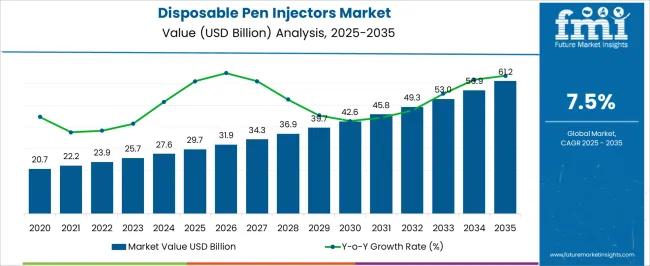
| Metric | Value |
|---|---|
| Disposable Pen Injectors Market Estimated Value in (2025 E) | USD 29.7 billion |
| Disposable Pen Injectors Market Forecast Value in (2035 F) | USD 61.2 billion |
| Forecast CAGR (2025 to 2035) | 7.5% |
The disposable pen injectors market is expanding steadily, driven by the increasing prevalence of chronic diseases, rising demand for self administration devices, and greater emphasis on patient safety. Growing cases of anaphylaxis and other acute conditions have reinforced the need for reliable drug delivery mechanisms that are both accessible and easy to use.
Technological advancements in design and formulation compatibility are improving device reliability and patient adherence. Regulatory approvals and favorable reimbursement policies are also contributing to adoption across diverse healthcare systems.
With healthcare shifting toward patient centric models, disposable pen injectors are expected to remain critical in ensuring efficient delivery of life saving drugs, particularly in emergency and outpatient care settings. The outlook remains positive with innovation in device ergonomics, safety features, and affordability shaping the future trajectory of this market.
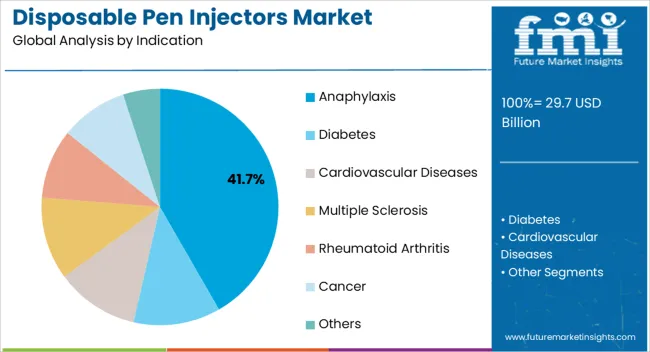
The anaphylaxis indication segment is projected to account for 41.70% of total market revenue by 2025, making it the leading therapeutic area. Growth is being driven by the rising incidence of severe allergic reactions and the critical need for immediate drug administration to prevent life threatening outcomes.
Disposable pen injectors have emerged as essential emergency tools due to their portability, ease of use, and ability to deliver accurate dosages quickly. Increasing public awareness and availability of epinephrine injectors in schools, workplaces, and public areas are further reinforcing demand.
Regulatory encouragement for wider accessibility and initiatives promoting patient and caregiver training have also contributed to the leadership of this segment.
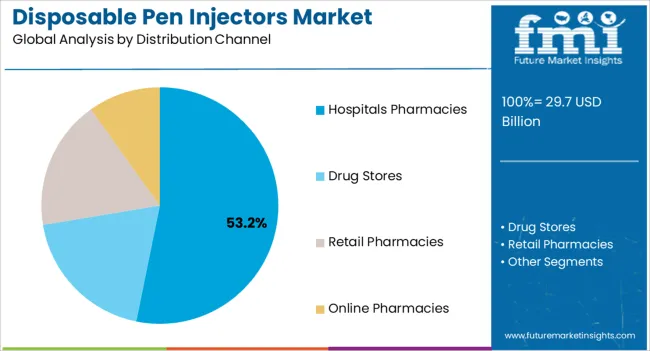
The hospitals pharmacies distribution channel segment is expected to represent 53.20% of total market revenue by 2025, establishing it as the dominant distribution route. This growth is supported by the rising preference of patients and healthcare providers for hospital affiliated pharmacies to ensure authenticity, quality assurance, and timely availability of disposable pen injectors.
The ability to integrate device distribution with clinical guidance and patient education enhances adoption and compliance rates. Hospitals pharmacies are also central to large scale procurement for institutional use, further strengthening their position.
As healthcare infrastructure continues to expand and patient reliance on trusted clinical channels increases, this segment is anticipated to maintain its leadership in the distribution channel landscape.
From 2012 to 2025, the global disposable pen injectors market experienced a CAGR of 6.1%, reaching a market size of USD 29.7 billion in 2025.
From 2012 to 2025, The Disposable Pen Injectors Market has grown steadily over the past ten years as a result of factors such the rising incidence of chronic diseases, technological improvements, and the demand for patient-friendly drug delivery systems.
Disposable pen injectors have grown in popularity as a practical and precise way for patients to self-administer medication, particularly for illnesses like diabetes.
Future Forecast for Disposable Pen Injectors Industry:
Looking ahead, the global disposable pen injectors industry is expected to rise at a CAGR of 7.9% from 2025 to 2035. In the upcoming years, the disposable pen injectors market is anticipated to keep expanding. The prevalence of chronic diseases is on the rise, pen injector technology is improving, biologic medicines are being used more frequently, and patient-centric care is prioritized.
These factors are all contributing to the market's growth. The growing older population and the demand for personalized medication are some factors driving the market.
Ongoing technological developments in disposable pen injectors, such as electronic dose monitoring, connection features, and integration with digital health systems, are also anticipated to have a positive impact on the market. These developments improve remote monitoring capabilities, medication adherence, and patient engagement.
| Country | The United States |
|---|---|
| Market Size (USD billion) by End of Forecast Period (2035) | USD 61.2 billion |
| CAGR % 2025 to End of Forecast (2035) | 7.3% |
The disposable pen injectors industry in the United States is expected to reach a market size of USD 61.2 billion by 2035, expanding at a CAGR of 7.3%. The need for patient convenience, cost effectiveness, and lessening the pressure on healthcare facilities is driving a growing trend in home healthcare in the USA With the help of disposable pen injectors, patients can self-administer medication at home, cutting down on the number of trips to the doctor.
| Country | The United Kingdom |
|---|---|
| Market Size (USD billion) by End of Forecast Period (2035) | USD 2.7 billion |
| CAGR % 2025 to End of Forecast (2035) | 7.2% |
The disposable pen injectors industry in the United Kingdom is expected to reach a market share of USD 2.7 billion, expanding at a CAGR of 7.2% during the forecast period. Disposable pen injectors provide patients with a user-friendly and convenient method of administering medications.
They offer features like pre-filled cartridges, adjustable dosing options, and simple operation, allowing patients to self-administer their medications at home or on the go. This trend towards patient-centered care and self-management contributes to the growth of the disposable pen injectors market.
| Country | China |
|---|---|
| Market Size (USD billion) by End of Forecast Period (2035) | USD 4.6 billion |
| CAGR % 2025 to End of Forecast (2035) | 9.1% |
The disposable pen injectors industry in China is anticipated to reach a market size of USD 4.6 billion, moving at a CAGR of 9.1% during the forecast period. China has been increasing its healthcare expenditure in recent years, focusing on improving healthcare infrastructure, access, and quality of care.
This increased investment supports the development and adoption of advanced medical devices like disposable pen injectors. Improved access to healthcare services and reimbursement policies contribute to the growth of the market.
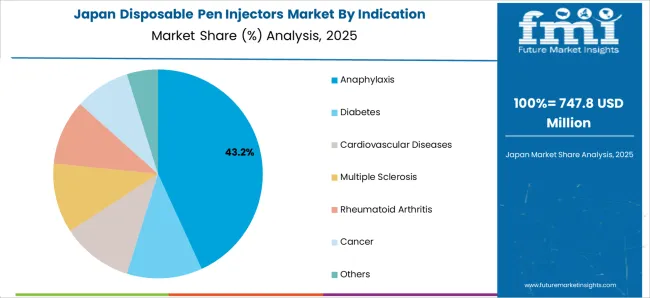
| Country | Japan |
|---|---|
| Market Size (USD billion) by End of Forecast Period (2035) | USD 2.6 billion |
| CAGR % 2025 to End of Forecast (2035) | 8.1% |
The disposable pen injectors industry in Japan is estimated to reach a market size of USD 2.6 billion by 2035, thriving at a CAGR of 8.1%. Education programs and initiatives that raise awareness about the benefits and proper usage of disposable pen injectors are crucial for market growth. Healthcare providers and pharmaceutical companies play a significant role in educating patients about the advantages of using disposable pen injectors, enhancing patient knowledge and acceptance.
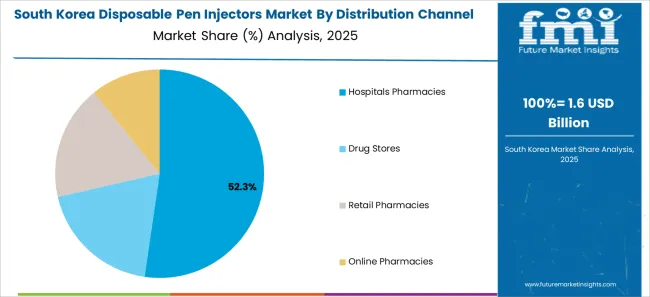
| Country | South Korea |
|---|---|
| Market Size (USD billion) by End of Forecast Period (2035) | USD 2.4 billion |
| CAGR % 2025 to End of Forecast (2035) | 8.6% |
The disposable pen injectors industry in South Korea is expected to reach a market size of USD 2.4 billion, expanding at a CAGR of 8.6% during the forecast period. The South Korean government has implemented various initiatives to promote self-care and home healthcare, aiming to improve patient outcomes and reduce healthcare costs. Disposable pen injectors align with these initiatives by enabling patients to self-administer medications at home, reducing the need for frequent hospital visits and improving patient empowerment.
The Diabetes is expected to dominate the disposable pen injectors industry with a CAGR of 7.5% from 2025 to 2035. High blood sugar levels are a defining characteristic of diabetes, a chronic illness. It is a problem for global health, and its prevalence has been rising over time.
Disposable pen injectors are one of the diabetes management solutions that are in high demand due to the rising prevalence of the disease. Disposable pen injectors are designed to be user-friendly and convenient. They feature pre-filled insulin cartridges and adjustable dosing options, making it easier for individuals with diabetes to administer insulin accurately. The convenience and ease of use offered by disposable pen injectors contribute to their popularity among patients.
The hospitals pharmacies segment is expected to dominate the disposable pen injectors industry with a CAGR of 7.1% from 2025 to 2035. This segment captures a significant market share in 2025 as hospital pharmacists play a crucial role in patient education and counseling. They provide information on proper medication usage, administration techniques, and injection site rotation.
For patients using disposable pen injectors, hospital pharmacists educate them on how to assemble and use the device correctly, ensuring safe and effective medication administration.
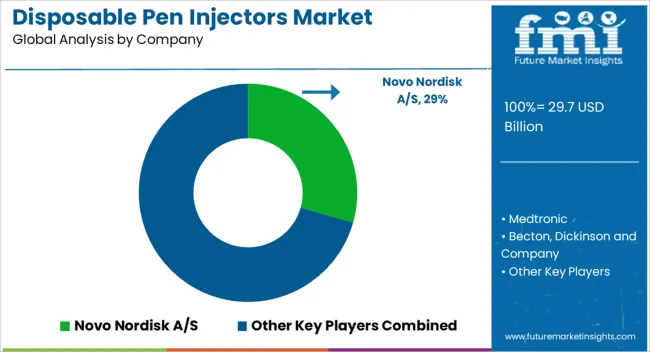
The disposable pen injectors sector is fiercely competitive, with many companies fighting for market dominance. To stay ahead of the competition in such a circumstance, essential players must employ smart techniques.
Key Strategies Used by the Participants
Product Development
To produce innovative goods that increase efficacy, dependability, and cost-effectiveness, businesses make significant investments in research and development. Product innovation enables companies to stand out from the competition while also meeting the shifting needs of their customers.
Strategic Alliances & Collaborations
Key industry leaders frequently develop strategic partnerships and collaborations with other companies in order to harness their strengths and increase their market reach. Companies might also gain access to new technology and markets through such agreements.
Expansion into Emerging Markets
The disposable pen injectors sector is expanding rapidly in emerging regions such as China and India. Key firms are enhancing their distribution networks and developing local manufacturing facilities to increase their presence in these areas.
Acquisitions and mergers
Mergers and acquisitions are frequently used by key players in the disposable pen injectors business to consolidate their market position, extend their product range, and gain access to new markets.
Key Developments in the Disposable Pen Injectors Market:
The global disposable pen injectors market is estimated to be valued at USD 29.7 billion in 2025.
The market size for the disposable pen injectors market is projected to reach USD 61.2 billion by 2035.
The disposable pen injectors market is expected to grow at a 7.5% CAGR between 2025 and 2035.
The key product types in disposable pen injectors market are anaphylaxis, diabetes, cardiovascular diseases, multiple sclerosis, rheumatoid arthritis, cancer and others.
In terms of distribution channel, hospitals pharmacies segment to command 53.2% share in the disposable pen injectors market in 2025.






Full Research Suite comprises of:
Market outlook & trends analysis
Interviews & case studies
Strategic recommendations
Vendor profiles & capabilities analysis
5-year forecasts
8 regions and 60+ country-level data splits
Market segment data splits
12 months of continuous data updates
DELIVERED AS:
PDF EXCEL ONLINE
Disposable Drills Market Size and Share Forecast Outlook 2025 to 2035
Disposable Food Containers Market Size and Share Forecast Outlook 2025 to 2035
Disposable Protective Apparel Market Size and Share Forecast Outlook 2025 to 2035
Disposable Plates Market Size and Share Forecast Outlook 2025 to 2035
Disposable Hygiene Adhesives Market Size and Share Forecast Outlook 2025 to 2035
Disposable Umbilical Cord Protection Bag Market Size and Share Forecast Outlook 2025 to 2035
Disposable E-Cigarettes Market Size and Share Forecast Outlook 2025 to 2035
Disposable Trocars Market Analysis - Size, Share, and Forecast Outlook 2025 to 2035
Disposable Cups Market Size and Share Forecast Outlook 2025 to 2035
Disposable Electric Toothbrushes Market Size and Share Forecast Outlook 2025 to 2035
Disposable Barrier Sleeves Market Size and Share Forecast Outlook 2025 to 2035
Disposable Plastic Pallet Market Size and Share Forecast Outlook 2025 to 2035
Disposable Curd Cups Market Size and Share Forecast Outlook 2025 to 2035
Disposable Egg Trays Market Size and Share Forecast Outlook 2025 to 2035
Disposable Blood Pressure Cuffs Market Analysis - Size, Share & Forecast 2025 to 2035
Disposable Cutlery Market Size, Growth, and Forecast 2025 to 2035
Disposable Spinal Instruments Market Analysis - Size, Share, and Forecast 2025 to 2035
Disposable Lids Market Analysis - Growth & Forecast 2025 to 2035
Disposable Face Mask Market Insights – Growth & Demand 2025 to 2035
The Disposable Insulin-delivery Device Market is segmented by Delivery Pumps, Patches, Pens, and Syringes from 2025 to 2035

Thank you!
You will receive an email from our Business Development Manager. Please be sure to check your SPAM/JUNK folder too.
Chat With
MaRIA